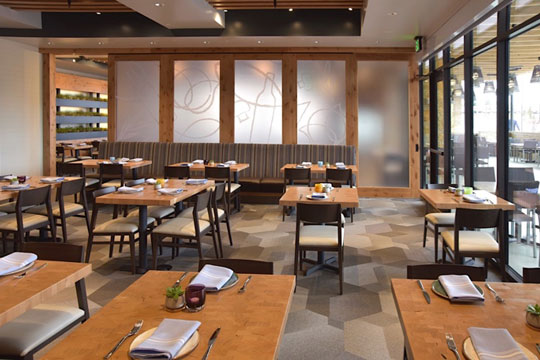Savor Authentic Oriental Cuisine With a Pan-Asian Spin for a Culinary Adventure
Beginning on a culinary trip with genuine Asian cuisine, boosted with a Pan-Asian spin, provides a special opportunity to explore the abundant tapestry of flavors that specify the region's diverse cooking practices. As you consider these luring meals, think about the cultural stories and historic influences that shape them, each bite using a story waiting to be found. Best ambiance restaurants Islamabad.

Exploring Pan-Asian Flavors
In the realm of worldwide gastronomy, Pan-Asian food attracts attention for its remarkable diversity and the unified interplay of tastes from various Oriental cultures. This cooking method commemorates the rich practices and unique components located across the continent, developing a tapestry of preferences that is both intriguing and enjoyable. Secret to Pan-Asian food is its capability to balance different tastes-- pleasant, salted, spicy, and sour-- while highlighting the quality and quality of each ingredient.
From the umami-rich soy sauce of Japan to the fiery chili peppers of Thailand, Pan-Asian food supplies a substantial scheme of flavors. These elements are usually combined in innovative means, boosting dishes with layers of intricacy. As an example, making use of great smelling natural herbs such as lemongrass and cilantro, common in Vietnamese and Thai cuisine, adds a refreshing brightness to recipes, while the consolidation of coconut milk delivers a creamy, abundant structure.
The focus on fresh fruit and vegetables and fragrant spices makes sure that each dish is not just a banquet for the taste however likewise for the senses. Pan-Asian food welcomes restaurants to start a cooking trip, discovering the large and differed landscapes of Eastern gastronomy with every bite.
Fusion Recipes to Try
While Pan-Asian food is commemorated for its standard tastes, the contemporary cooking landscape is progressively welcoming blend recipes that blend these classic aspects with influences from other areas. This innovative method not only honors the rich heritage of Oriental culinary arts however additionally introduces unique taste experiences that appeal to modern tastes buds.
A prime example of such a combination meal is the Korean-Mexican taco, where marinaded bulgogi beef is covered in a warm tortilla, covered with kimchi and a zesty gochujang-infused salsa. This combination marries the vibrant, tasty flavors of Korea with the dynamic, fresh aspects of Mexican food. Likewise, sushi burritos have actually acquired popularity, amalgamating the fragile artistry of Japanese sushi with the hearty, hand-held ease of a burrito, frequently featuring fusion components like tempura shrimp and avocado with a drizzle of wasabi mayo.
Another noteworthy recipe is Thai curry ramen, which instills the velvety, aromatic seasonings of Thai curry right into the calming broth of standard Japanese ramen, creating a harmonious blend that tantalizes the detects. These blend meals extend past mere uniqueness; they stand for a culinary dialogue between societies, motivating exploration and innovation worldwide of Pan-Asian food.
Essential Active Ingredients and Spices
To truly appreciate Pan-Asian cuisine, one have to understand the necessary active ingredients and seasonings that develop its structure. This varied cooking design attracts from an abundant tapestry of Eastern customs, utilizing an unified mix of flavors and textures. Secret active ingredients consist of soy sauce, fish sauce, and oyster sauce, which pass on a mouthwatering umami depth important to Oriental meals. Corresponding to these are rice vinegar and mirin, lending a fragile level of acidity and sweetness.
Aromatic aspects are crucial, with garlic, lemongrass, and ginger being ubiquitous across numerous Pan-Asian dishes. These ingredients supply a great smelling base that boosts the intricacy of tastes. Spices such as star anise, cardamom, and cinnamon introduce warmth and personality, osaka restaurant resembling impacts from areas like China and India.

Food Preparation Strategies and Tips
Mastering the art of Pan-Asian cuisine calls for familiarity with its distinctive cooking techniques, each adding to the vibrant tapestry of flavors this cooking practice is my explanation celebrated for. Central to these approaches is the stir-fry, a quick food preparation strategy that preserves the dietary stability and brilliant colors of components. Utilizing a wok, the stir-fry method allows for even heat circulation, vital for accomplishing the particular texture and flavor equilibrium of Pan-Asian dishes.
One more basic strategy is steaming, especially prevalent in Chinese food. This gentle method maintains the all-natural flavors and nutrients of active ingredients, making it ideal for fish and shellfish and vegetables. Dumplings, a precious staple, typically profit from steaming, leading to soft, delicious textures.
Grilling, also integral, imparts great smoky midsts to recipes such as Oriental bulgogi or Japanese yakitori (asian fusion restaurant). This method commonly entails marinading active ingredients, allowing tastes to penetrate deeply prior to cooking over an open flame or warm plate
Lastly, understanding the art of stabilizing flavors-- pleasant, sour, salted, bitter, and umami-- is vital. Appropriately layering these aspects can boost a meal from regular to extraordinary, offering a complicated and pleasing culinary experience that personifies the significance of look what i found Pan-Asian food.
Dining Experiences Worldwide
Across the globe, Pan-Asian cuisine supplies an unequaled eating experience, commemorated for its rich tapestry of flavors and dynamic discussions. This cooking phenomenon has gone beyond social limits, recording the hearts and tastes of food enthusiasts worldwide. In cosmopolitan cities like New York, London, and Sydney, Pan-Asian restaurants work as fusions where culinary practices from Thailand, Japan, China, and past converge, supplying diners with a diverse mix of recipes that highlight the region's diversity.
The international appeal of Pan-Asian cuisine lies in its capacity to offer both credibility and development. Cooks skillfully marry typical active ingredients such as lemongrass, soy sauce, and miso with contemporary techniques, causing recipes that are both refreshingly new and acquainted. This blend permits restaurants to embark on a culinary journey that values heritage while welcoming modernity.
In addition, eating experiences are raised via thoughtfully designed environments that show the principles of Pan-Asian appearances. From minimal Japanese-inspired insides to vivid Thai-themed spaces, each restaurant provides a distinct atmosphere that matches the cooking offerings. Consequently, clients are not just eating a dish however partaking in a cultural experience, making Pan-Asian eating a really worldwide sensation.
Final Thought
The exploration of Pan-Asian food offers an extensive understanding of the intricate interplay of tastes and culinary traditions throughout Asia. By welcoming fusion recipes such as Thai curry ramen and sushi burritos, the culinary journey not only highlights the versatility of traditional active ingredients yet also showcases ingenious contemporary strategies. This gastronomic adventure, enhanced by cooking techniques and essential seasonings, supplies an unique possibility to value the multiculturalism and cooking creativity that specify Pan-Asian cuisine on an international scale.
Getting started on a culinary journey through genuine Oriental cuisine, enhanced with a Pan-Asian spin, supplies an one-of-a-kind possibility to discover the rich tapestry of tastes that define the region's varied cooking customs.In the world of international gastronomy, Pan-Asian food stands out for its remarkable diversity and the unified interplay of tastes from different Eastern societies. Secret to Pan-Asian cuisine is its capability to balance contrasting tastes-- pleasant, salty, spicy, and sour-- while highlighting the freshness and quality of each active ingredient.
